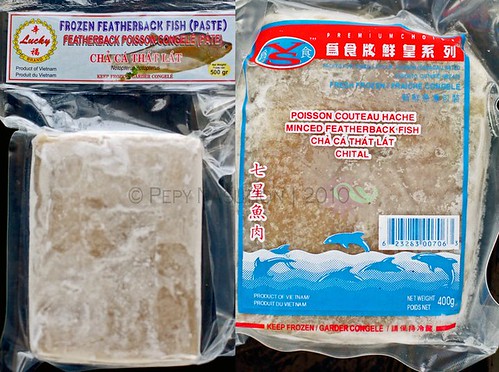
This kind of dim sum is a popular meal in Indonesia as a street/hawker food. The difference between Chinese traditional dimsum with the Indonesian is the sauce. We enjoy siomay with peanut sauce that has a kick from chili and drizzle with citrus juice (usually from jeruk limo (aka nasnaran mandarin or leprous lime) or jeruk purut (aka kaffir lime).
Most Indonesians use king mackerel fish (ikan tenggiri) meat for the filling. But, you can find other filling variants such as shrimp or chicken or different type of fish. For my recipe, I used featherback fish (ikan belida) paste. Ikan belida was traditionally used by Palembangese (South Sumatrans) for making kerupuk (crackers), pempek (fish cake with tamarind sauce) and otak-otak (grilled fish cake wrapped in banana leaves). I'm attaching the picture of ikan belida paste below.
Other complements to siomay bandung are hard boiling eggs, afilled cabbage, potatoes, bitter melon, and tofu.
As some of you know that I'm not a big fan of hard boiled eggs, I never add them to my plate. In this case, I totally forgot to buy fresh tofu and potato, so I used tofu puffs and skipped the potato.
Note: I slightly change the NCC's recipe to my liking. I used almost all roasted ingredients. Find the tips for making easier sambal kacang below the recipe.
Siomay Bandung
-Bandung Style Steamed Dumplings with Peanut Sambal-
recipe by NCC (Natural Cooking Club), modified and translated by me
Ingredients:
500 g featherback fish (ikan belida) paste -> can be substituted for other white fish or shrimp or chicken
2 tsbp shallots, grated
1 tbsp mashed roasted garlic -> NCC: grated garlic
2 tsp ground white pepper
1 tsp dried shrimp (ebi), ground -> NCC: chicken bouillon
1 tsp fish sauce -> my idea
2 1/2 tsp sugar
2 tsp salt
1 tsbp sesame oil
3 eggs
400 g chayotte or jicama, shredded
450 g tapioca starch
round wonton skins
bittermelon
cabbage
tofu puffs

Featherback Fish (Ikan Belida) Paste
Sambal Kacang (Peanut Sambal)
400 g garlicky roasted peanuts
100 g garlicky roasted cashew nuts
150 g red cayenne pepper (reduce the amount to your liking), roasted
3 cloves roasted garlic, mash with a spoon
2 tbsp canesugar vinegar
2 tbsp salt
7 tbsp coconut sugar (gula jawa, gula merah)
500 g baked sweet potato (about 2 regular size sweet potatoes), peeled
1.5 L water
Methods:
1. In a big bowl, combine fish paste with shallot, garlic, white pepper, dried shrimp, fish sauce, sugar, salt and sesame seed oil. Then add egg and mix well.
2 Add chayotte or jicama, mix well. Add tapioca starch and mix well again. Set aside.
3. Steam all of these below for about 20-30 minutes. Grease the steamer with very small amount of oil if you need, so the dumplings won't be sticky.
--> Siomay:
Take one piece of the wonton skin, scoop 1 tbsp of filling on the centre of the skin. Shape the siomay using hands and leave the top open. Repeat the step until all wonton skin are used up. Steam for 20-30 minutes.
--> Tofu and Potato Soybean Cake & Potato:
Cut in half and scrape a portion of tofu & potato side and fill it in with the filling. Do the same step if you use tofu puffs.
--> Bitter Melon
Cut in 3 to 4 pieces. I cut up to 5 pieces since the bittermelon size is quite bigger here. Scrape the seed portion and fill it in with the base filling.
--> Cabbage:
Many recipes suggested to dip the leaves in to hot water for a few seconds since they don't fill the cabbage leaves with fish paste mixture. I prefer using the Ukrainian way of making holubtsi (cabagge roll). Steam the whole head of cabbage until soften. Cut the leaves off of the cabbage and cut the larger leaves in half. Spoon 1 tablespoon of filling into a leaf and roll tightly. Place rolls in a prepared casserole dish. Ready for steaming.
--> Egg
Hard boiled eggs split in half, paste on a mixture of fish.
Sambal Kacang (Peanut Sambal)
1. Process peanuts and cashew nuts in a food processor until smooth (I like a bit crunchy, everyone who loves smoother texture can process a bit longer). Transfer into a bowl. Set aside.
2. Process red cayenne pepper and garlic until smooth. Add sweet potato and process again. Add ground nuts; process. Add salt, vinegar, sugar and combine again. Do a taste test, if it's perfect for your tastebuds then it's ready to serve.
Seving suggestions: place all dumpling on a plate, cut to bite sizes if you like. Add peanut sambal and drizzle over the juice of leprous lime or kaffir lime, kecap manis and ketchup. I usually serve another side of chili sambal if people want to have more heat.
Tips:
* Use ready to use natural peanut and cashew butter from a store. I like using the natural ones since there is no other additions beside the nuts and salt. Some natural health stores in Winnipeg offer a service for us to grind the unsalted roasted peanuts that we buy there.
*In this recipe, I made my own garlicky roasted peanuts and cashew nuts. Soak the nuts in warm water with lots of mashed garlics, add a bit of salt if you like. Leave them overnight. The next morning, drain them and roast in a pan with extra virgin coconut oil (add just enough, don't put too much). Before the nuts turn golden brown (about a half of roasting time), add garlic slices.
* You can always roast the cayenne pepper with the whole head of garlics. If you have a left over roasted garlic, you can apply for your toast or spice up others foods.
0 comments:
Post a Comment